Intel X58 Motherboard Roundup - What does $300 Get You?
by Gary Key on December 5, 2008 3:00 PM EST- Posted in
- Motherboards
ASUS P6T Deluxe
Features
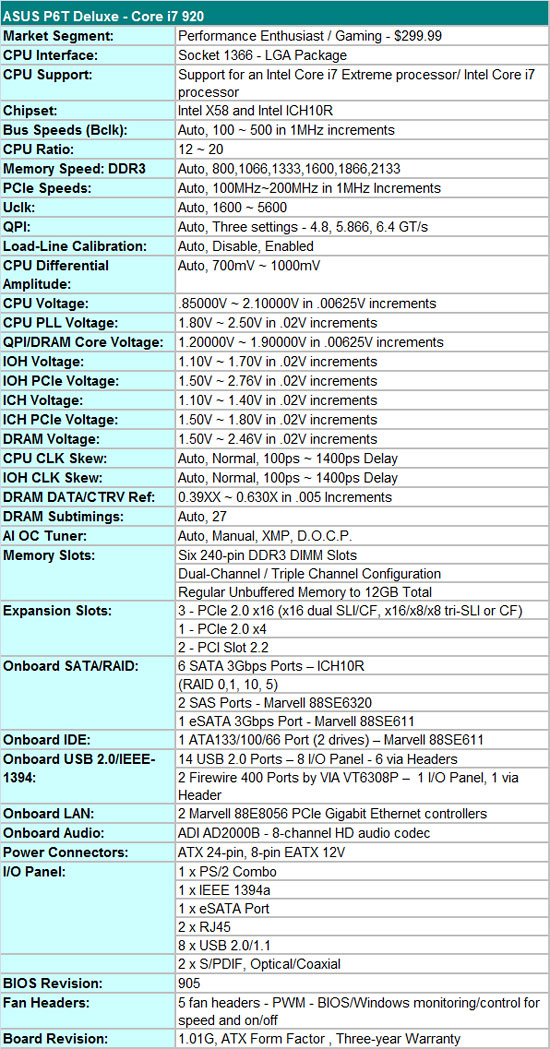
ASUS offers the P6T Deluxe in two different versions, one with the OC Palm external display module for $338 and one without for $299. The OC Palm was originally introduced as the ScreenDuo last year and features a 2.5" QVGA display, four-way directional pad, and four input buttons. It attaches to the motherboard via a USB cable and features a clean, uncluttered, and simplistic interface that allows the user to interface with various ASUS software programs. The user can monitor various hardware functions or do on-the-fly overclocking. The unit allows real-time changes to the processor's Bclk along with voltages for QPI, memory bus, and the CPU. We would like to see additional overclocking variables along with the ability to save profiles to the BIOS or real-time changes to the BIOS. Overall, it is a unique feature and fun to play with for about 30 minutes, but for most users we would suggest saving the money and buying the base board - A board that we might add is one of our favorites in the lab since it first arrived.
Not to take anything away from our other boards as they are all very good with one bordering on being great, but the ASUS P6T-Deluxe impressed us with its ability to just work as expected out of the box. While we provided several suggestions to ASUS for improvements, they mainly centered on tuning aspects, not getting basic functions to work properly before we could even consider testing. That may seem trivial, but unfortunately it is not if you are an early adopter of high-end motherboards.
The BIOS is designed for a wide variety of users who want to get the most out of a board when overclocking. Some of the voltage ranges are not as wide as Gigabyte's, nor do you have the ability to control each individual memory channel, but the options available will more than suffice for most users. We also think the ASUS BIOS is more user friendly due to the information provided for each option. However, ASUS continues to use the terminology QPI/DRAM instead of VTT as the other boards do.
ASUS features memory speeds from 800MHz to 2133MHz memory for the i920/i940 processors along with opening up QPI link speeds from a standard 4.800 GT/s up to 6.400 GT/s. We are disappointed with the number of OC profiles in the BIOS. ASUS has three OC profiles compared to up to eight on the other boards.
The board officially supports 12GB of DDR3 memory, although we expect full support for 24GB in a future BIOS release. Running 12GB of memory on this board is extremely easy and it usually requires less voltage while providing tighter timings than the other boards. Our 12GB Patriot and G.Skill DDR3-1600 kits were 24/7 stable at 1600 with 8-8-8-24 1T timings, although we needed about 1.66V for absolute stability. The Gigabyte board offered slightly better latency results with 9-8-8-24 1T timings, but the ASUS board was just slightly faster in most of the benchmarks except for WinRAR. Of course, your mileage will vary with different memory kits and sub-timings, and outside of memory benchmarks the net difference is generally less than 1%.
One last item of note, at least in this first look, is that the three PCI Express 2.0 x16 slots will operate in x16/x16 mode for 2x SLI/CF if the third x16 slot is empty. If you decide to place a PCIe RAID, network, audio, or TV tuner card in the third x16 slot, then the 2x SLI/CF configuration will operate in x16/x8 mode. We did not notice any performance differences between the two modes with our HD 4870 or GTX 260 cards. 3x SLI/CF configurations will run in x16/x8/x8 mode. You can also use the first and third x16 slots for graphics if you need to open up a PCI slot but the board will run in x16/x8 mode. Although the owner’s manual states the three x16 slots are for graphics cards only, we had no problems running our ASUS Xonar D2X or Highpoint Rocket RAID cards in x16 slot two or three.
The Board
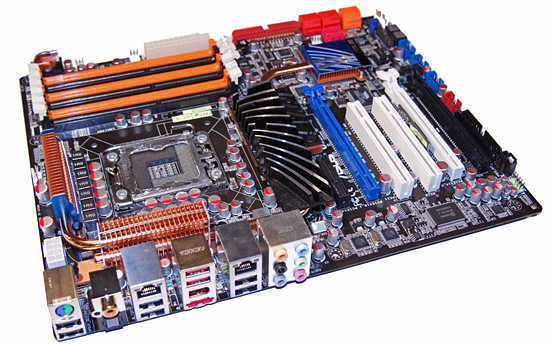
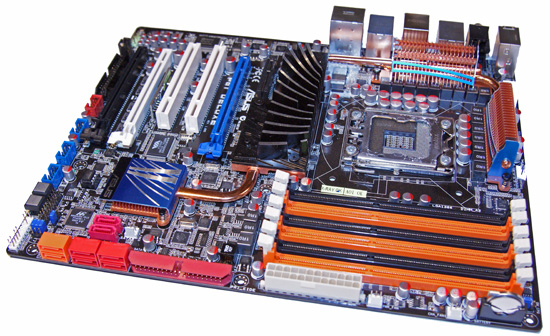
The P6T Deluxe carries over the orange and black decor from previous ASUS DDR3 boards along with a blue and white slot motif. While not exactly as colorful as previous Gigabyte boards or as subdued as the MSI board, it does work well enough; we prefer the flagship ROG color palettes. ASUS has constantly improved their layouts over time and the P6T Deluxe reflects this with a design that is virtually free of clearance problems. While not as loaded as the Gigabyte board, ASUS still has a substantial amount of items to squeeze onto the motherboard.
The first item we notice on the P6T Deluxe is the heatsink and thermal pipe setup encircling the CPU socket area. The CPU socket is centered to the DIMM slots as we noticed on the Gigabyte board. The engineers tell us this is to optimize the memory trace paths resulting in higher overclocks and improved stability. The various heatsinks are low-profile designs featuring a completely passive setup in order to keep noise to a minimum. ASUS utilizes a swept fan design for the northbridge, a small but effective fin array for the ICH10R, and a couple of relatively low-profile fin arrays for the PWM area.
All of this equates to a CPU area that is basically void of clearance issues with large air coolers, although the capacitors are little close to the 1366 socket for the more extreme cooling options. The P6T Deluxe features 23 power phases, which certainly sounds impressive, but we are still not sure if quantity is better than quality in this regard. ASUS dedicates 16 for the processor core and another three memory, two each for the memory/QPI controller and chipset. The Gigabyte and MSI boards feature two individual two-phase designs for the memory and QPI systems.
On the other end of the board we have a bevy of SATA ports and the IDE connector. The six red ports are tied to the ICH10R while the two orange ones attach to a Marvell 88SE6320 Serial Attached SCSI controller. Backwards compatibility built into the SAS standard allows current SATA drives to work. When utilizing a standard SATA drive, performance is close to the ICH10R and definitely a step ahead of the JMicron controllers on the other boards. As a plus, it will do RAID 0 and 1 arrays, and ASUS includes SAS cables in the box. We appreciate the right angle connectors as they ensure there will not be any clearance issues with longer cards. However, ports 5 and 6 use a standard design that results in a very tight fit with a couple of GTX280s installed.
ASUS includes onboard power and reset buttons, but curiously forgot to include a clear CMOS button. After weeks of testing, it is a feature we miss, even though ASUS' BIOS recovery system rarely let us down. Moving forward, we have three physical x16 slots available for graphics in a x16/x8/x8 configuration with a 3X setup. In order to run a 3X setup, the second GPU will have to be a single slot solution... which sort of defeats the purpose of 3-way support, since the current NVIDIA 3-way SLI cards are all dual slot solutions. Still, you can add in a card for PhysX processing if you'd like. In a 2x CF/SLI setup, the user ends up with a x16/x16/x1 configuration. An additional x4 slot is at the top of the board that can accommodate full length cards. To top it off, two PCI slots are available, but the first one will be blocked by double-slot graphics card.
ExpressGate is included on this board and the riser card is located between the second PCIe x16 and PCI slots. In addition to the riser card, the board features onboard headers for an additional IEEE 1394a port and six USB ports. The user ends up with a total of 14 usable USB ports, two more than the ICH10R supports. That means some sharing is going on between the ports, but we never noticed a problem with the board loaded out.
Finally we get to the IO panel that features a single combo PS/2 port, eight USB ports, two Gigabit LAN ports, a single IEEE 1394a and eSATA port, and optical and coaxial S/PDIF out ports. The audio panel features connection jacks to the Analog Devices AD2000B codec, probably the last time we will see this codec since ADI has exited the PC audio business.
The Application
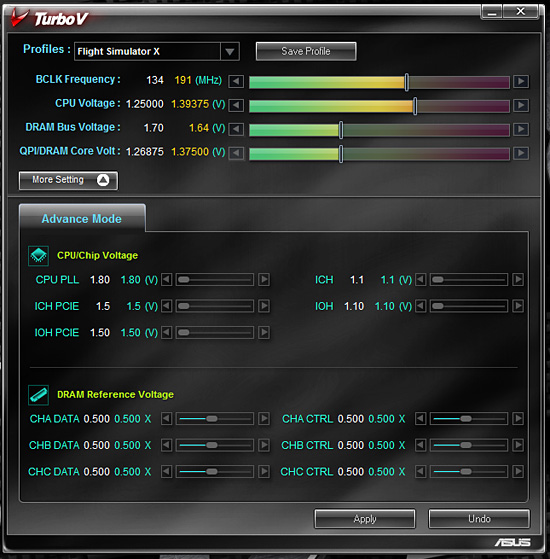
TurboV is ASUS' latest Windows based overclocking utility that features the ability to change most major BIOS settings to improve overclocking rates. It features profiles and works quite well, provided the memory timings and CPU multiplier have been set up properly prior to entering Windows. We are still hopeful that one of the major suppliers will offer the same capabilities as AMD's AOD utility.
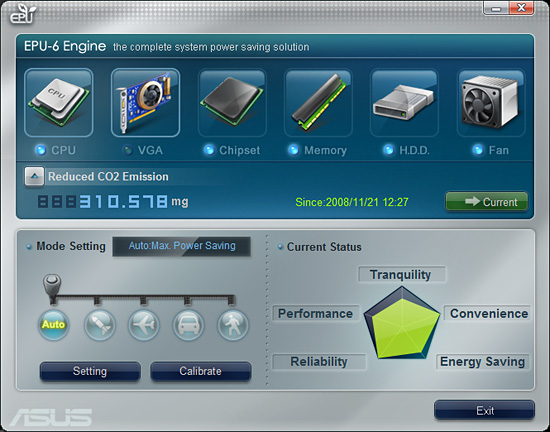
The P6T Deluxe features the EPU-6 power savings technology that can be accessed through the EPU software. The program offers five different modes or levels of energy savings. After hours of testing each setting, we found that leaving the application on Auto with a proper calibration worked best. Utilizing EPU-6 resulted in a power savings of 5W at both idle and load settings.
















78 Comments
View All Comments
TantrumusMaximus - Monday, December 8, 2008 - link
THANK YOU THANK YOU ANAND.I haven't had a chance to read the entire article but did read all of Anand's comments and am floored. Good Job keep it up and we readers appreciate it. It's gone out of control, prices through the roof for mobos and QA is through the floor. The comments of "why would you want 12GB?" coming from the Manuf mouth is just unsettling at best... if I choose to populate 6 DIMM slots that better work, they're there, and I expect em to work not to be asked WHY I want 12GB!!!!
CarlosMC - Monday, December 8, 2008 - link
You just saved me over 1000€ on a new system - guess I'll stick to my 939 for the time being and if things won't change, maybe I'll find better things to do with my money and, specially, my time.DaveLessnau - Monday, December 8, 2008 - link
And, while talking about the basic quality of the board and the company behind it, don't forget to talk about the manufacturer's web site. Specifically, does it have a forum where people can talk about the individual boards? How slow is the site, itself? Can you actually download things at reasonable speeds? Also, how's the English on the site and also in the documentation (to internationalize that a bit, for any localized site that the company maintains, is the local language real or does it read like something run through Google Translate?)?Emperor88 - Monday, December 8, 2008 - link
"Hey guys, Anand here. I'm writing this sub-section, not at Gary's request, but because I felt it was necessary."I was really pleased to read that section. Not because of the problems experienced, which is terrible and motherboard makers really need to pull their heads in, but because of the honesty shown. More of that kind of commentary would be great, thanks :)
I think you should add the problems you experience in getting things working correctly in every article. Even briefly would be better than nothing as it paints a deceptive picture of the product's abilities if left off as all the amazing performance figures are presented without acknowledging the hours of fiddling required (by professionals no less!) to get the products up to scratch.
Zak - Monday, December 8, 2008 - link
I would be happy to get a mobo that has the basics and no on-board sound, NIC and RAID controllers. These devices often fail and can't be replaced. I'd rather opt for a plain but fast and stable $100 mobo with twice the number of PCI-e slots so I can pick my own devices. Oh, and no legacy stuff: serial, parallel, floppy controller. But I wonder how many reviewers would give it low ratings because it's not overloaded with features?Z.
strikeback03 - Monday, December 8, 2008 - link
Would need a new motherboard/case standard, obviously ATX couldn't accommodate twice the PCI-E slots. And this will probably never happen, as they seem to not be able to decide when to phase out support for legacy standards such as PCI and floppy. I can't wait to see IDE go, and Intel was onboard with that plan several chipsets ago, put pretty much everyone still includes IDE connectors.Rindis - Wednesday, December 10, 2008 - link
How do you figure? Most motherboards just have ~3 PCI-E slots + PCI. Remove PCI and you have plenty of room for the expanded PCI-E handling.I'll admit I've still got a lot of legacy devices with life in them, so I'm not so keen on abandoning it all. But, as long as it's not a case of abandoning legacy on every motherboard immediately, I think it's past time we see some pure PCI-E + SATA + USB boards.
I'll also agree with two posts above. My preferred motherboard configuration is no video, no sound, no network. Okay, network controllers are at the point where I use the on-board ones now; but I know of good, reliable, well-priced cards that beat whatever will be on the board, and I don't want to pay for the features I won't be using, and I don't want to have to worry about smashing them into submission. (Which is also better today, but I remember all too well the headaches of turning early on-board audio off.)
michal1980 - Sunday, December 7, 2008 - link
This whole motherboard hell is one reason, I didn't even consider upgrading my pc in the past 2 years (that and a quad intel @3ghz is plenty for just about anything right now)Ever time I upgraded I went through 2-3 motherboards because ethier they were broken out of the box, or had issues with some other piece of hardware. And its everyone, i've had issues, with evga, gigabyte, asus, abit, etc etc.
What I really couldnt understand, is most times, I spent the extra money to get the mobo that got good reviews from sites like Anand.
So while I'm glad your finally going after Mobo manufactures, I feel that you guys bare some of the responsiblity because you allowed it to happen.
To all readers, just how bad must it be that Anand is finally. FINALLY speaking out? If his speaking out, the boards must be total CRAP. Just plain junk, not only that, 300 dollar junk.
Part of the problem IMHO, is all this built in stuff, its nice, but it causes corners to be cut, built in network cards, heck, lets make it 2, built in sound cards, etc etc. I'm not even sorry, after a new mobo comes out, i'm waiting 6+ months before i'm even going to consider buying one. I'm sick of being the QA for these manufacture
SixOfSeven - Sunday, December 7, 2008 - link
In the discussion of the ASUS P6T, you state "The board officially supports 12GB of DDR3 memory, although we expect full support for 24GB in a future BIOS release." Can you share the basis for this claim? In particular, does ASUS guarantee that P6Ts purchased now will eventually be able to support 24GB with some later BIOS upgrade?CEO Ballmer - Sunday, December 7, 2008 - link
Intell is on the ball!http://fakesteveballmer.blogspot.com">http://fakesteveballmer.blogspot.com